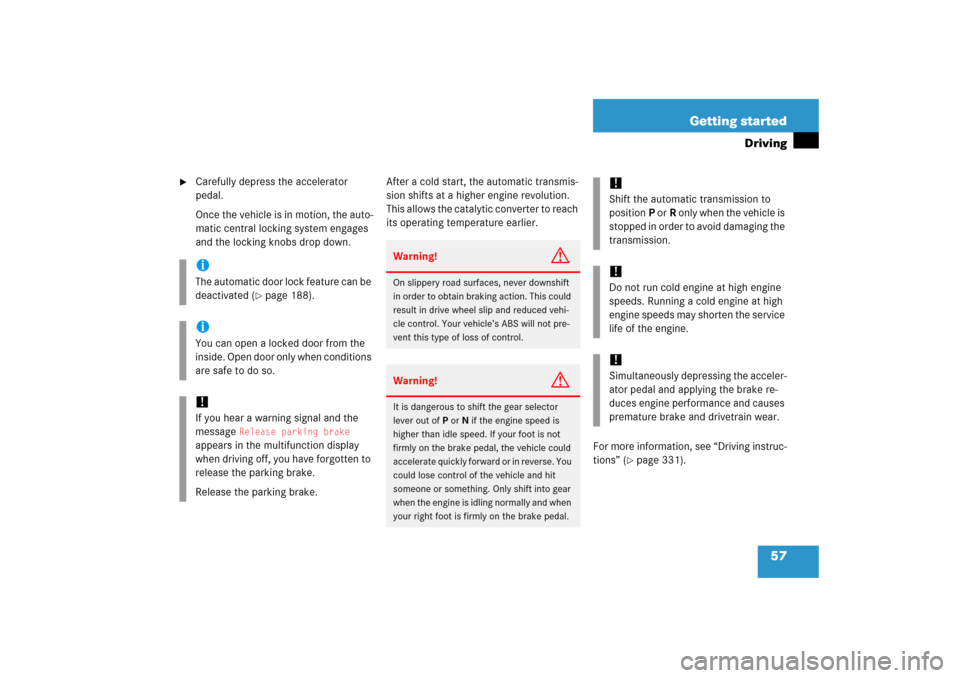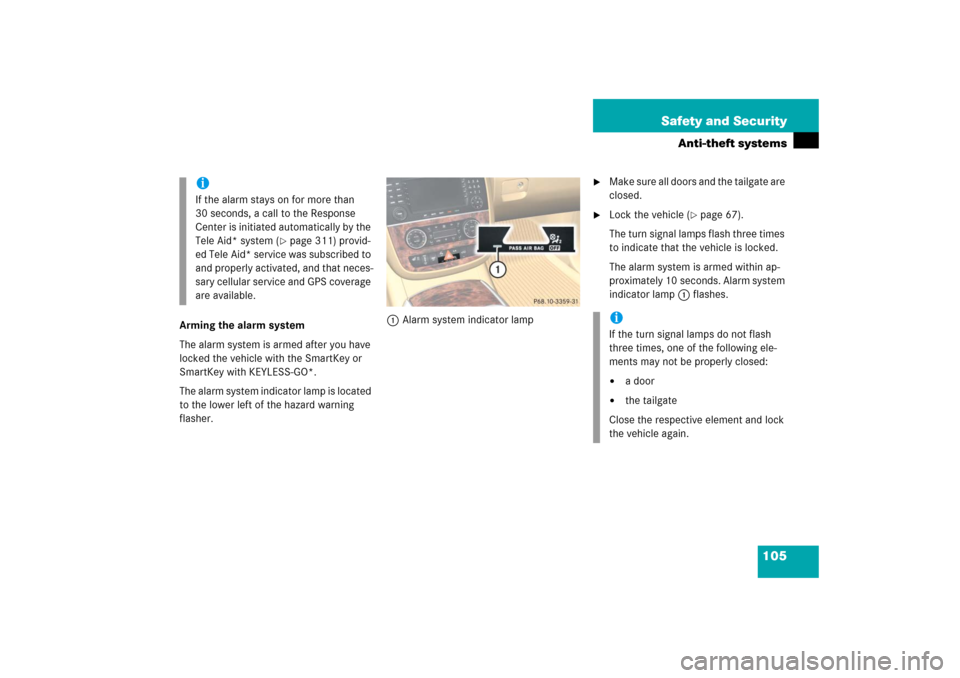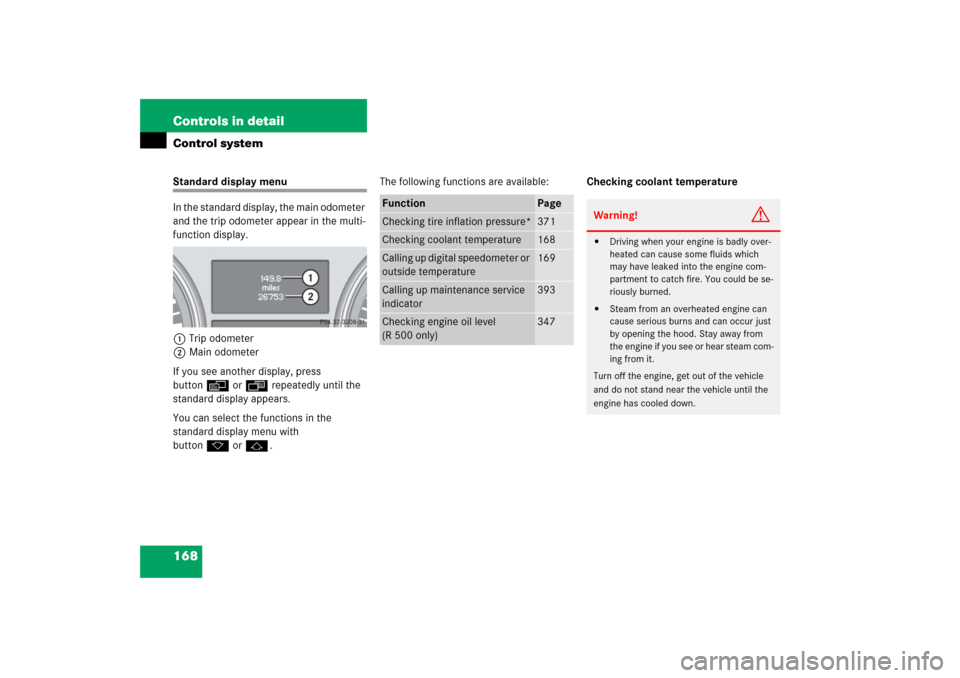Page 20 of 561

19 Introduction
Vehicle data recording
�Vehicle data recording
Information regarding electronicrecording devices
(Including notice pursuant to California Code § 9951)
Please note that your vehicle is equipped with devices that can record vehicle systems data and, if equipped with the Tele Aid* system,
may transmit some data in certain accidents.
This information helps, for example, to diagnose vehicle systems after a collision and to continuously improve vehicle safety.
DaimlerChrysler may access the information and share it with others�
for safety research or vehicle diagnosis purposes
�
with the consent of the vehicle owner or lessee
�
in response to an official request by law enforcement or other government agency
�
for use in dispute resolution involving DaimlerChrysler, its affiliates or sales / service organization and / or
�
as otherwise required or permitted by law.
Please check the Tele Aid* subscription service agreement for details regarding the information that may be recorded or transmitted
via that system.
Page 58 of 561

57 Getting started
Driving
�
Carefully depress the accelerator
pedal.
Once the vehicle is in motion, the auto-
matic central locking system engages
and the locking knobs drop down.After a cold start, the automatic transmis-
sion shifts at a higher engine revolution.
This allows the catalytic converter to reach
its operating temperature earlier.
For more information, see “Driving instruc-
tions” (
�page 331).
iThe automatic door lock feature can be
deactivated (
�page 188).
iYou can open a locked door from the
inside. Open door only when conditions
are safe to do so.!If you hear a warning signal and the
message
Release parking brake
appears in the multifunction display
when driving off, you have forgotten to
release the parking brake.
Release the parking brake.
Warning!
G
On slippery road surfaces, never downshift
in order to obtain braking action. This could
result in drive wheel slip and reduced vehi-
cle control. Your vehicle’s ABS will not pre-
vent this type of loss of control.Warning!
G
It is dangerous to shift the gear selector
lever out ofP orN if the engine speed is
higher than idle speed. If your foot is not
firmly on the brake pedal, the vehicle could
accelerate quickly forward or in reverse. You
could lose control of the vehicle and hit
someone or something. Only shift into gear
when the engine is idling normally and when
your right foot is firmly on the brake pedal.
!Shift the automatic transmission to
positionP orR only when the vehicle is
stopped in order to avoid damaging the
transmission.!Do not run cold engine at high engine
speeds. Running a cold engine at high
engine speeds may shorten the service
life of the engine.!Simultaneously depressing the acceler-
ator pedal and applying the brake re-
duces engine performance and causes
premature brake and drivetrain wear.
Page 86 of 561

85 Safety and Security
Occupant safety
Occupant Classification System
The Occupant Classification System (OCS)
automatically turns the front passenger
front air bag on or off based on the classi-
fied occupant weight category determined
by weight sensor readings from the front
passenger seat.
Occupants must sit properly belted in a
nearly upright position with their back
against the seat backrest and feet on the
floor to be correctly classified. If the occu-
pant’s weight is transferred to another
object in the vehicle (e.g. by leaning on
armrests), the OCS may not be able to
properly approximate the occupant’s
weight category.Furthermore, the occupant weight may ap-
pear to increase or decrease due to
objects hanging on the seat, other passen-
gers pushing on the seat, objects lodged
underneath the seat or stuffed between
seat and middle console or between seat
and door or due to objects applying pres-
sure on the back of the seat. Always make
sure the seat has clearance in all direc-
tions at all times.
Both, driver and the front passenger
should always use the 59 in-
dicator lamp as an indication of whether or
not the front passenger is properly posi-
tioned.
When the child restraint is not in use, re-
move it from the vehicle or secure it with the
seat belt to prevent the child restraint from
becoming a projectile in the event of an ac-
cident.
Do not leave children unattended in the ve-
hicle, even if the children are secured in a
child restraint system. Unsupervised chil-
dren in a child restraint system may use
vehicle equipment and may cause an acci-
dent and / or serious personal injury.
iThe system does not deactivate the
front passenger side impact air bag,
the window curtain air bag, and the
emergency tensioning device.
iIf your seat, including your trim cover
and cushion needs to be serviced in
any way, take the vehicle to an autho-
rized Mercedes-Benz Light Truck
Center.
Only seat accessories approved by
Mercedes-Benz may be used.
Page 106 of 561

105 Safety and Security
Anti-theft systems
Arming the alarm system
The alarm system is armed after you have
locked the vehicle with the SmartKey or
SmartKey with KEYLESS-GO*.
The alarm system indicator lamp is located
to the lower left of the hazard warning
flasher.1Alarm system indicator lamp
�
Make sure all doors and the tailgate are
closed.
�
Lock the vehicle (
�page 67).
The turn signal lamps flash three times
to indicate that the vehicle is locked.
The alarm system is armed within ap-
proximately 10 seconds. Alarm system
indicator lamp 1 flashes.
iIf the alarm stays on for more than
30 seconds, a call to the Response
Center is initiated automatically by the
Tele Aid* system (
�page 311) provid-
ed Tele Aid* service was subscribed to
and properly activated, and that neces-
sary cellular service and GPS coverage
are available.
iIf the turn signal lamps do not flash
three times, one of the following ele-
ments may not be properly closed:�
a door
�
the tailgate
Close the respective element and lock
the vehicle again.
Page 107 of 561

106 Safety and SecurityAnti-theft systemsDisarming the alarm system�
Unlock the vehicle (
�page 36).
The turn signal lamps flash once to
indicate that the vehicle is disarmed.Canceling the alarm
To cancel the alarm:
With the SmartKey
�
Insert the SmartKey in the starter
switch.
or
�
Press theŒ or ‹button on the
SmartKey.
With KEYLESS-GO*
�
Grasp an outside door handle.
The SmartKey with KEYLESS-GO must
be within 3 ft (1 m) of the vehicle.
or
�
Press the KEYLESS-GO start / stop
button (
�page 40).
The SmartKey with KEYLESS-GO must
be inside the vehicle.
Tow-away alarm
Once the tow-away alarm is armed, a visual
and audible alarm will be triggered when
someone attempts to raise the vehicle.
iThe alarm system will rearm automati-
cally again after approximately
40 seconds if neither a door nor the
tailgate is opened.
iThe tow-away protection alarm is trig-
gered, for example, if the vehicle is
lifted on one side.
If the alarm stays on for more than
30 seconds, a call to the Response
Center is initiated automatically by the
Tele Aid* system (
�page 311) provid-
ed Tele Aid* service was subscribed to
and properly activated, and that neces-
sary cellular service and GPS coverage
are available.
Page 162 of 561

161 Controls in detail
Control system
�Control system
The control system is activated as soon as
the SmartKey in the starter switch is
turned to position1 (
�page 38) or as
soon as the KEYLESS-GO start / stop but-
ton* is in position1 (�page 39). The con-
trol system enables you to
�
call up information about your vehicle
�
change vehicle settings
For example, you can use the control sys-
tem to find out when your vehicle is next
due for maintenance service, to set the
language for messages in the instrument
cluster display, and much more.
The control system relays information to
the multifunction display.
Multifunction display
1Trip odometer
2Main odometer
3Gear position indicator
4Current transmission program mode
5Status indicator (outside temperature
or digital speedometer)
For more information on menus displayed
in the multifunction display, see “Menus”
(�page 164).
iThe displays for the audio systems
(radio, CD player) will appear in English,
regardless of the language selected.
Warning!
G
A driver’s attention to the road and traffic
conditions must always be his/her primary
focus when driving.
For your safety and the safety of others, se-
lecting features through the multifunction
steering wheel should only be done by the
driver when traffic and road conditions per-
mit it to be done safely.
Bear in mind that at a speed of just 30 mph
(approximately 50 km/h), your vehicle is
covering a distance of 44 feet (approximate-
ly 14 m) every second.
Page 166 of 561

165 Controls in detail
Control system
Menus, submenus and functions
Menu1
Menu2
Menu3
Menu4
Menu5
Standard display
AUDIO
NAV*
Airmatic/
Compass
Vehicle status message
memory
(�page 168)
(�page 170)
(�page 172)
(�page 172)
(�page 173)
Commands/submenusTrip- and main odometer
Selecting radio station
Show route guidance
instructions, current
direction traveled
Airmatic*
Calling up vehicle malfunction,
warning and system status
messages stored in memory
Checking tire inflation pressure*
Selecting satellite ra-
dio station* (USA only)
Compass
Checking coolant temperature
Operating CD player
Calling up digital speedometer or
outside temperatureCalling up maintenance service
indicatorChecking engine oil leveliThe headings used in the menus table
are designed to facilitate navigation
within the system and are not neces-
sarily identical to those shown in the
control system displays. The first func-
tion displayed in each menu will auto-
matically show you which part of the
system you are in.
Page 169 of 561

168 Controls in detailControl systemStandard display menu
In the standard display, the main odometer
and the trip odometer appear in the multi-
function display.
1Trip odometer
2Main odometer
If you see another display, press
buttonè orÿ repeatedly until the
standard display appears.
You can select the functions in the
standard display menu with
buttonkorj.The following functions are available:Checking coolant temperature
Function
Page
Checking tire inflation pressure*
371
Checking coolant temperature
168
Calling up digital speedometer or
outside temperature
169
Calling up maintenance service
indicator
393
Checking engine oil level
(R 500 only)
347
Warning!
G
�
Driving when your engine is badly over-
heated can cause some fluids which
may have leaked into the engine com-
partment to catch fire. You could be se-
riously burned.
�
Steam from an overheated engine can
cause serious burns and can occur just
by opening the hood. Stay away from
the engine if you see or hear steam com-
ing from it.
Turn off the engine, get out of the vehicle
and do not stand near the vehicle until the
engine has cooled down.